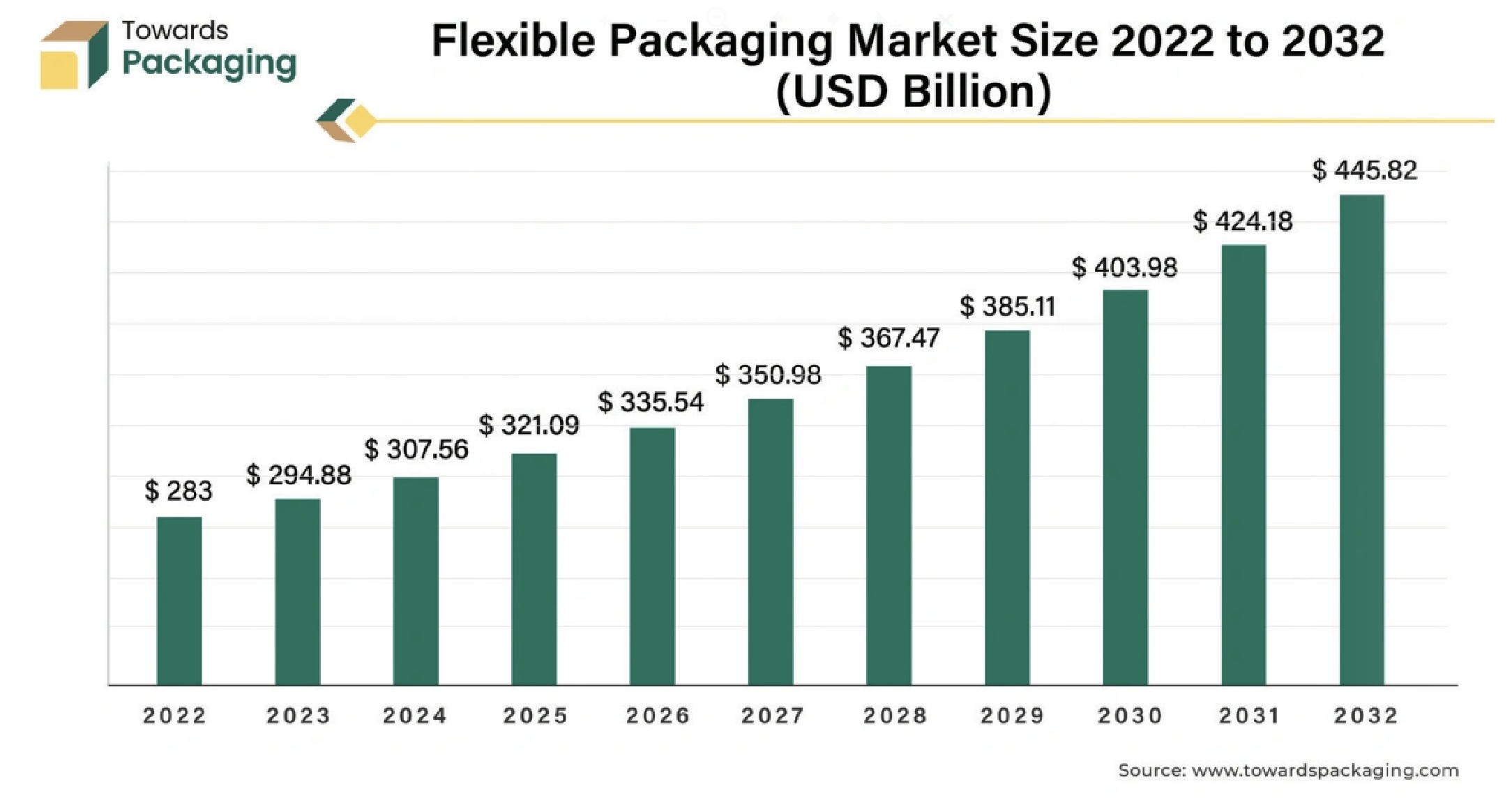Merging Innovation and Sustainability in Flexible Packaging
- Published: November 04, 2024
Optimizing Product Protection, Minimizing Material Usage
By Swapna Gawale, Research Consultant, Towards Packaging
Flexibility in packaging has emerged as a cornerstone of innovation, revolutionizing the way products are stored, transported and presented to consumers. Leveraging materials such as plastic, film, paper and aluminum foil, flexible packaging provides a robust yet lightweight solution that optimizes product protection while minimizing material usage.
With continuous advancements in technology, the industry has witnessed the development of lighter-weight packaging solutions that enhance shelf appeal, strength and sealability.
The global flexible packaging market size1 is on a trajectory of remarkable growth, poised to witness a substantial increase from $283 billion in 2022 to an expected $445.82 billion by 2032, reflecting a 4.7 percent CAGR between 2023 and 2032.
Flexible packaging offers unparalleled advantages in terms of versatility, sustainability and cost-effectiveness. In this comprehensive analysis, we delve into the flexible packaging market statistics2 spanning from 2023-2032, exploring the driving factors, regional dynamics, market trends and future projections.
Market Trends and Emerging Opportunities
The rise of e-commerce has ushered in a new era of opportunities and challenges for the flexible packaging industry. While e-commerce presents avenues for growth and expansion, it also necessitates innovative packaging solutions to meet the demands of online retail channels. Moreover, the increasing emphasis on sustainability and environmental conservation has prompted manufacturers to explore bio-plastic alternatives and invest in recycling infrastructure.
Challenges and Opportunities in Recycling
While the demand for flexible packaging continues to soar, challenges persist in the efficient recycling of plastic materials. Inadequate recycling infrastructure and low recycling rates pose significant obstacles to market expansion. Addressing these challenges requires collaborative efforts from governments, businesses and consumers to invest in advanced recycling technologies and promote responsible consumption habits.
Benefits of Flexible Packaging
- Enhanced production efficiency:
- Utilizes less base material than rigid packaging.3
- Flexible materials facilitate quicker production and lower energy consumption.
- Environmental friendliness:
- Requires less energy during production.
- Materials are often reusable and recyclable.
- Innovative package design and customization:
- Allows for creative and distinctive packaging shapes.
- Combined with advanced printing and design services, creates visually appealing packaging for better marketing impact.
- Extended product life:
- Shields products from moisture, UV rays, mold, dust and other contaminants.
- Maintains product quality and extends shelf life.
- User-friendly packaging:
- Lighter and less bulky, making it easier for customers to purchase, transport and store products.
Strong Consumer Demand for Environment-Conscious Flexible Packaging Solutions
Implementing new regulatory initiatives by governments worldwide has created a compelling impetus for plastic packaging manufacturers4 to explore innovative packaging solutions and drive the growth of the packaging industry.
Manufacturers are increasingly recognizing the importance of sustainable packaging5 solutions as a means to reduce costs and ensure the preservation of product integrity.
Sustainable packaging options are characterized by using fewer materials, resulting in cost savings and environmental benefits. Furthermore, these solutions reduce transportation expenses and enable extended shelf-life for packaged products, enhancing customer satisfaction and minimizing waste.
Flexible packaging encompasses a diverse array of materials, shapes and sizes, catering to various packaging needs. Unlike rigid packaging, such as cans or bottles, flexible packaging is characterized by its ability to conform to the shape of the contents, offering optimal protection and preserving freshness.
- Sample pouches: Versatility in packaging.
- Printed pouches: Combining functionality with branding.
- Sachets: Convenience meets portability.
- Printed roll stock: Streamlining production.
- Stock bags: Customizable and cost-effective.
Advances/Growth in the Flexible Packaging Realm
Flexible packaging is a rapidly expanding industry that is expected to develop at a constant 6.2 percent annual pace through 2030. The primary cause of this increase is the increased demand for packaged foods and pharmaceutical and nutritional products. Innovative and environmentally friendly flexible packaging options are replacing traditional rigid packaging solutions as sustainability gains traction.
Flexible packaging is expected to become a competitive and practical alternative due to the growing market demand for consumer-friendly packaging and improved product protection. Eco-friendly activities, digital printing and e-commerce are major forces behind market expansion. Customers are becoming more and more prepared to pay more for particular product features made possible by flexible packaging.
According to studies conducted by the Flexible Packaging Association, for example, more than 60 percent of North American consumers are prepared to spend more for packaging that offers real and practical benefits including product protection, shipping compatibility and supply chain management efficacy.
Unprecedented Growth of Asia Pacific's Packaging Sector
Significant expansion in the flexible packaging industry is anticipated in the Asia-Pacific region, especially in India. In terms of economic sector size, the packaging industry is the fifth largest in India and is one of the fastest-growing in the nation.
According to the Packaging Industry Association of India, the industry is growing at a yearly rate of 22-25 percent. Expanding internet penetration, urbanization, changing lifestyles, rising income levels and strong economic growth are some of the factors driving this expansion. The fact that over one-third of Indians live in cities is noteworthy, and this tendency has increased consumer demand for high-quality packaged goods.
India has experienced a significant increase in the use of sustainable packaging in recent years, mostly due to rising packaged food consumption, rising consumer awareness and rising demand for high-quality goods. There has been an increase in consumer awareness of packaged food, especially food delivery services. Flexible packaging is becoming more and more popular in India because of its energy and environmental advantages.
The greatest qualities of plastic, paper and aluminum foil are combined in flexible packaging to provide freshness, barrier protection, durability, printability and user convenience without sacrificing sustainability.
The development of flexible packaging has been significantly aided by China and other Asia-Pacific nations. China's demand for packaged goods, such as food, drinks and personal hygiene items, is being driven by the country's fast industrialization, urbanization and rising disposable incomes. The region's booming e-commerce industry has increased demand for practical, lightweight packaging options, which has accelerated the use of flexible packaging.
Similar patterns are being seen in other Asia-Pacific nations including Thailand and Vietnam. In August 2023, the responsible packaging solutions developer and manufacturer Amcor agreed to purchase Phoenix Flexibles, an Indian company, for an unknown amount. Gujarat, India is home to Phoenix Flexibles' operations. The company sells flexible packaging for use in food, personal care and home care applications, bringing in roughly $20 million yearly.
Future of Packaging Flexibility Driving Environmental Progress
Innovations include storage and transportation alternatives in addition to consumer disposal techniques. Traditional mass production, shipping and storage methods cause a great deal of environmental damage because excess inventory is frequently disposed of in landfills.
Nonetheless, the use of space-saving solutions is being encouraged by recent developments and improved efficiency strategies. This trend highlights the move towards flexible packaging for stacking, storing and optimizing logistics especially in the food sector, where consumers value adaptability and convenience above all else.
Flexible packaging has many benefits, such as being lightweight, long-lasting and able to accommodate a wide range of product sizes and varieties. It simplifies handling, transit and consumption while reducing waste and negative effects on the environment.
A growing trend towards eco-friendly substitutes for traditional packaging materials like plastic is highlighted by the growing use of natural materials like bamboo, plant fibers and starches for edible and sustainable packaging choices.
Alternative materials are growing rapidly, since plastic continues to be widely utilized in flexible packaging.
Flexible packaging continues to be a competitive alternative to traditional plastic packaging in light of the growth of e-commerce, changing dietary habits, and the popularity of processed and packaged goods. Its continuous relevance and appeal in a market scenario that is rapidly evolving is underscored by its capacity to minimize waste, optimize transport space, and increase shelf life for food and beverage items.
In March 2024, Partners and INEOS introduced novel film packaging made 50 percent of recycled plastic. PepsiCo has introduced new Sunbites packaging for the renowned snack brand in the UK and Ireland. Using this pyrolysis oil instead of conventional fossil feedstock, INEOS Olefins & Polymers Europe initially produced recycled propylene at its plant before converting it into virgin-quality recycled polypropylene resin.
1-5 Source: https://www.towardspackaging.com/insights/flexible-packaging-market
About the Author
Swapna Gawale is a seasoned research consultant with expertise in conducting and analyzing complex research projects across various industries. Swapna has collaborated with numerous organizations to help them drive strategic growth. By leveraging advanced analytical tools and software, Swapna transforms complex data sets into concise and impactful reports that drive actionable insights.






